Novel Technologies towards the Implementation and Exploitation of “Green” Wireless Agriculture Sensors
Abstract
1. Introduction
2. Additively Manufactured Passive Agriculture Sensors for Humidity Sensing
2.1. A 3.5 GHz 3D-Printed Dipole
2.2. UHF 3D-Printed Dipole
3. Agriculture Sensors with Energy Harvesting Feature
3.1. ISM Sensor Platform with an Integrated UHF Energy Harvesting Feature
3.2. UHF Sensor Platform with an Integrated ISM Energy Harvesting Feature
4. Wireless Power Transfer from UAV-Carried Transmitters to Ground-Based Sensors
4.1. WPT at UHF Frequency–915 MHz
4.2. Communication Range between the UAV-Carried RFID Reader and the UHF Communication Module
4.3. UAV Readers with Beam-Forming Capability
5. Conclusions
Author Contributions
Funding
Institutional Review Board Statement
Informed Consent Statement
Data Availability Statement
Conflicts of Interest
References
- Singh, V. Advances in Precision Agriculture Technologies for Sustainable Crop Production. J. Sci. Res. Rep. 2024, 30, 61–71. [Google Scholar] [CrossRef]
- Misra, N.N.; Dixit, Y.; Al-Mallahi, A.; Bhullar, M.S.; Upadhyay, R.; Martynenko, A. IoT, Big Data, and Artificial Intelligence in Agriculture and Food Industry. IEEE Internet Things J. 2022, 9, 6305–6324. [Google Scholar] [CrossRef]
- Tagarakis, A.C.; Kateris, D.; Berruto, R.; Bochtis, D. Low-Cost Wireless Sensing System for Precision Agriculture Applications in Orchards. Appl. Sci. 2021, 11, 5858. [Google Scholar] [CrossRef]
- Bošković, M.V.; Šljukić, B.; Vasiljević Radović, D.; Radulović, K.; Rašljić Rafajilović, M.; Frantlović, M.; Sarajlić, M. Full-Self-Powered Humidity Sensor Based on Electrochemical Aluminum–Water Reaction. Sensors 2021, 21, 3486. [Google Scholar] [CrossRef] [PubMed]
- Kim, J.; Cho, J.-H.; Lee, H.-M.; Hong, S.-M. Capacitive Humidity Sensor Based on Carbon Black/Polyimide Composites. Sensors 2021, 21, 1974. [Google Scholar] [CrossRef] [PubMed]
- Martins, J.E.M.P. Physical Analysis of a Waterproof Temperature Sensor Responsiveness for Agricultural Applications. J. Agric. Inform. 2023, 13. [Google Scholar] [CrossRef]
- Song, C.; Liu, P.; Liu, X.; Liu, L.; Yu, Y. Configuration Optimization of Temperature–Humidity Sensors Based on Weighted Hilbert–Schmidt Independence Criterion in Chinese Solar Greenhouses. Agriculture 2024, 14, 311. [Google Scholar] [CrossRef]
- Xu, J.; Gu, B.; Tian, G. Review of agricultural IoT technology. Artif. Intell. Agric. 2022, 6, 10–22. [Google Scholar] [CrossRef]
- Chai, K.H.; Azizi, M.M.F.; Romeli, S.; Lau, H.Y. A Deployment of IoT sensors in the revolution of agriculture: IoT sensors in agriculture. RA J. Appl. Res. 2023, 9, 306–330. [Google Scholar] [CrossRef]
- Bhandari, S.; Krishnanand; Singh, A.; Taufik, M. 3D printing methods and materials for sensor fabrication. Mater. Today Proc. 2023; ISSN 2214-7853. [Google Scholar] [CrossRef]
- Gopalakrishnan, S.; Waimin, J.; Zareei, A.; Sedaghat, S.; Raghunathan, N.; Shakouri, A.; Rahimi, R. A biodegradable chipless sensor for wireless subsoil health monitoring. Sci Rep 2022, 12, 8011. [Google Scholar] [CrossRef] [PubMed]
- Hassan, M.S.; Zaman, S.; Dantzler, J.Z.R.; Leyva, D.H.; Mahmud, M.S.; Ramirez, J.M.; Gomez, S.G.; Lin, Y. 3D Printed Integrated Sensors: From Fabrication to Applications—A Review. Nanomaterials 2023, 13, 3148. [Google Scholar] [CrossRef] [PubMed]
- Bougas, I.D.; Papadopoulou, M.S.; Boursianis, A.D.; Kokkinidis, K.; Goudos, S.K. State-of-the-Art Techniques in RF Energy Harvesting Circuits. Telecom 2021, 2, 369–389. [Google Scholar] [CrossRef]
- Dang, T.H.; Tran, V.T.; Chung, W.Y. B2EH: Batteryless BLE Sensor Network Using RF Energy Harvesting. In Proceedings of the IEEE Applied Sensing Conference (APSCON), Bengaluru, India, 23–25 January 2023; pp. 1–4. [Google Scholar]
- Grosinger, J.; Görtschacher, L.; Bösch, W. Sensor add-on for batteryless UHF RFID tags enabling a low cost IoT infrastructure. In Proceedings of the IEEE MTT-S International Microwave Symposium (IMS), San Francisco, CA, USA, 22–27 May 2016; pp. 1–4. [Google Scholar]
- Ayir, N.; Riihonen, T. Impact of Software-Defined Radio Transmitter on the Efficiency of RF Wireless Power Transfer. In Proceedings of the IEEE Wireless Power Transfer Conference (WPTC), Seoul, Republic of Korea, 15–19 November 2020; pp. 83–86. [Google Scholar]
- Chien, W.C.; Hassan, M.M.; Alsanad, A.; Fortino, G. UAV–Assisted Joint Wireless Power Transfer and Data Collection Mechanism for Sustainable Precision Agriculture in 5G. IEEE Micro 2022, 42, 25–32. [Google Scholar] [CrossRef]
- Liu, Z.; Li, J. Application of Unmanned Aerial Vehicles in Precision Agriculture. Agriculture 2023, 13, 1375. [Google Scholar] [CrossRef]
- Chatzichristodoulou, D.; Quddious, A.; Vassiliou, L.; Shoaib, N.; Vryonides, P.; Nikolaou, S. Additive manufacturing techniques for 5G IoT antennas and sensors. In Proceedings of the IEEE 15th European Conference on Antennas and Propagation (EuCAP), Dusseldorf, Germany, 22–26 March 2021; pp. 1–5. [Google Scholar]
- Chatzichristodoulou, D.; Quddious, A.; Paolini, G.; Masotti, D.; Costanzo, A.; Vryonides, P.; Nikolaou, S. UHF and ISM Band MIMO Antenna for an Energy-Autonomous SWIPT system. In Proceedings of the 2022 IEEE International Symposium on Antennas and Propagation and USNC-URSI Radio Science Meeting (AP-S/URSI), Denver, CO, USA, 10–15 July 2022; pp. 191–192. [Google Scholar]
- Nadeem, A.; Chatzichristodoulou, D.; Vassiliou, L.; Vryonides, P.; Nikolaou, S. Energy Harvesting Supported Humidity Sensor for Agriculture Applications. In Proceedings of the Sensors and Electronic Instrumentation Advances (SEIA), Corfu, Greece, 21–23 September 2022; p. 161. [Google Scholar]
- Nadeem, A.; Chatzichristodoulou, D.; Kiani, H.; Quddious, A.; Vassiliou, L.; Shoaib, N.; Vryonides, P.; Nikolaou, S. Transmitter Considerations for 5G Wireless Powered Sensor Networks. In Proceedings of the 16th European Conference on Antennas and Propagation (EuCAP), Madrid, Spain, 27 March–1 April 2022; pp. 1–5. [Google Scholar]
- Frederick. Available online: https://icarus.frederick.ac.cy/ (accessed on 15 May 2024).
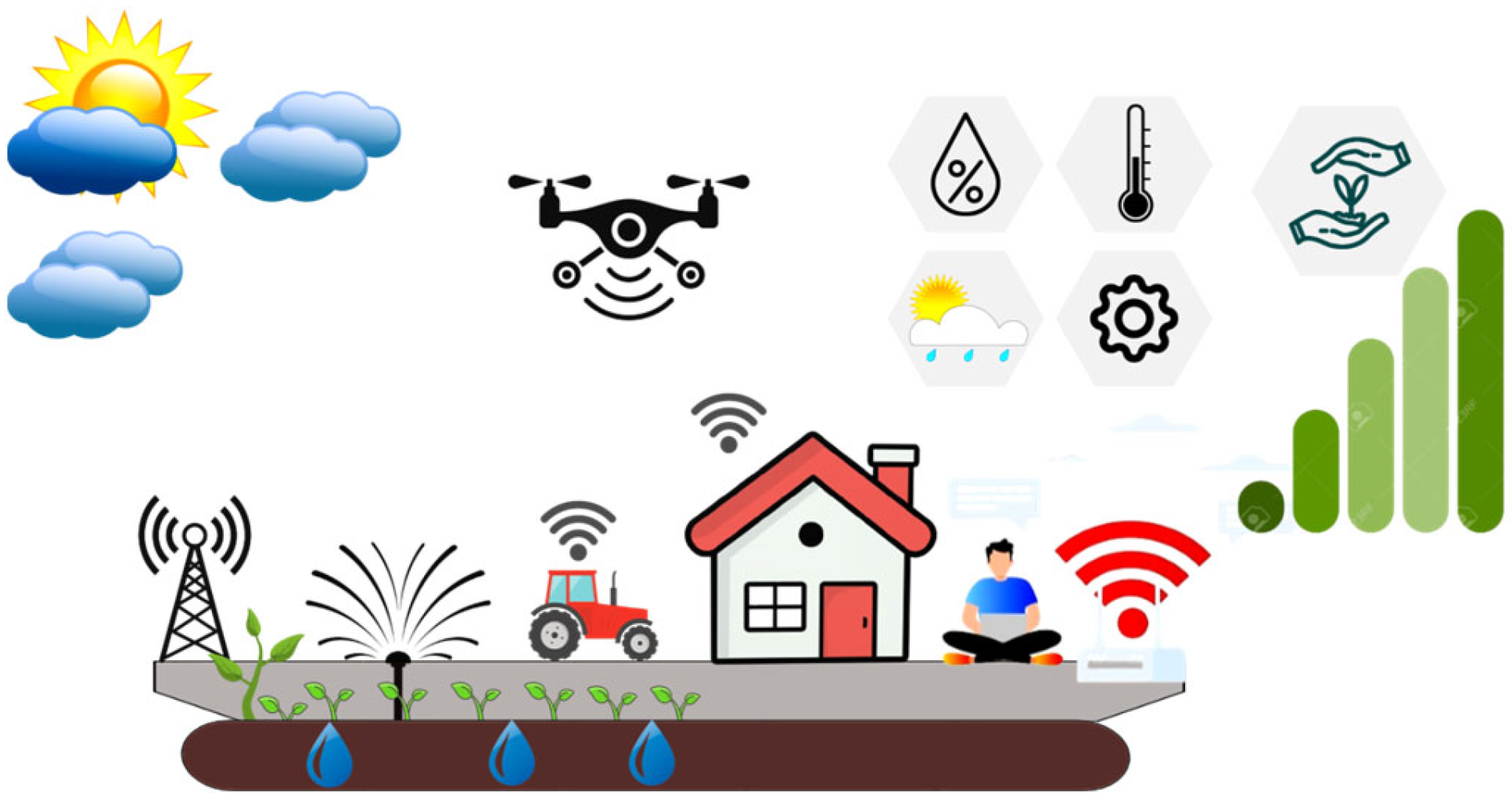
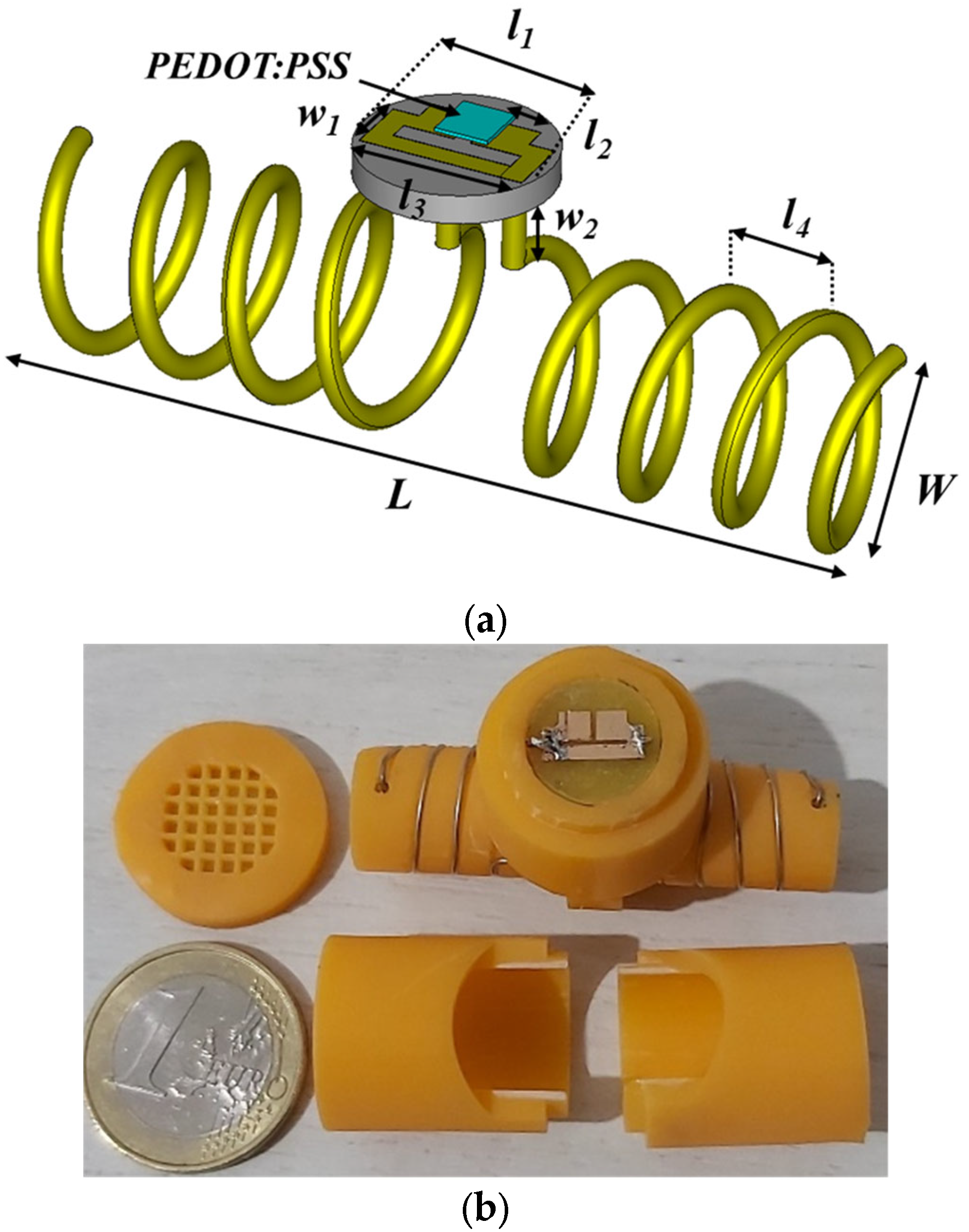
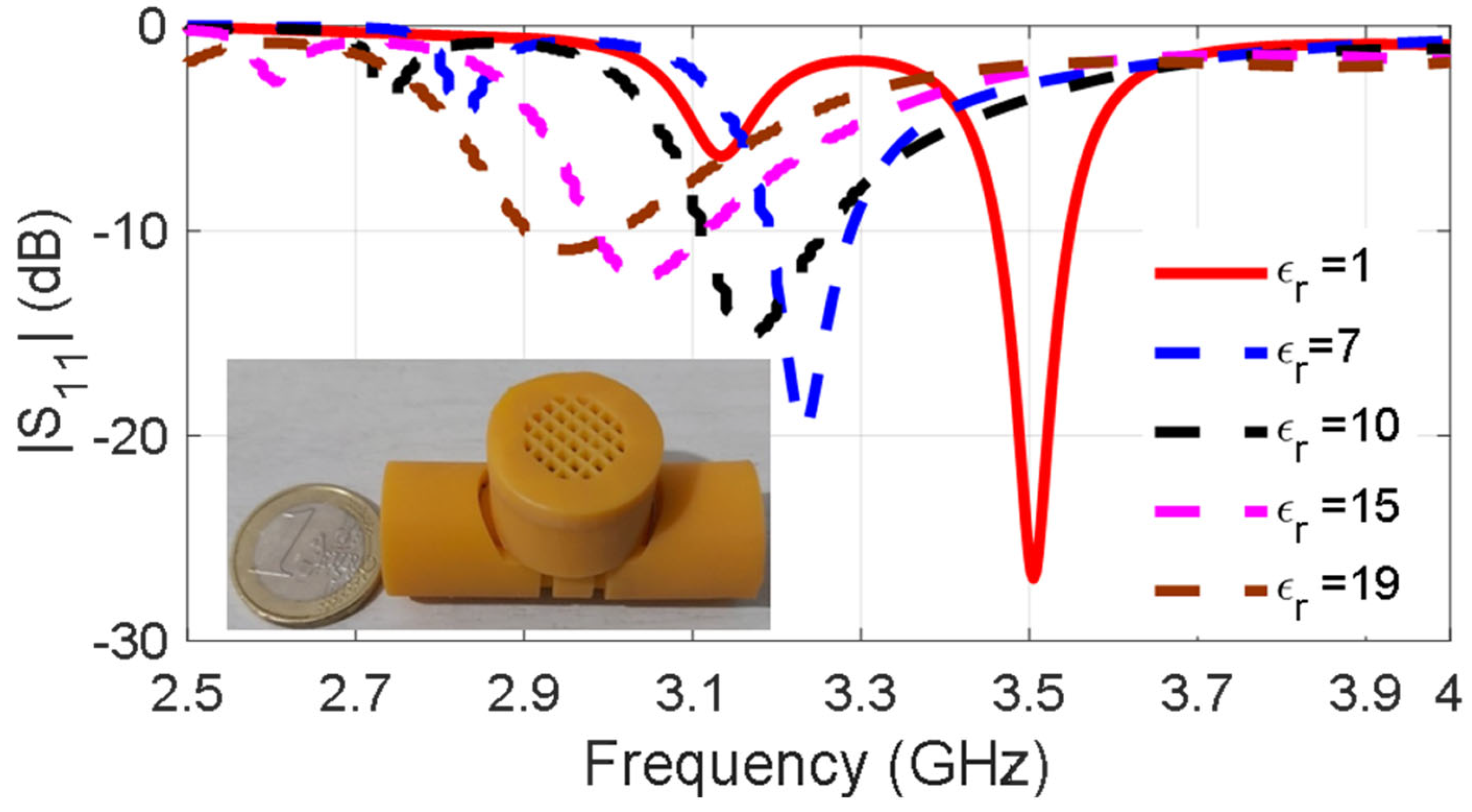







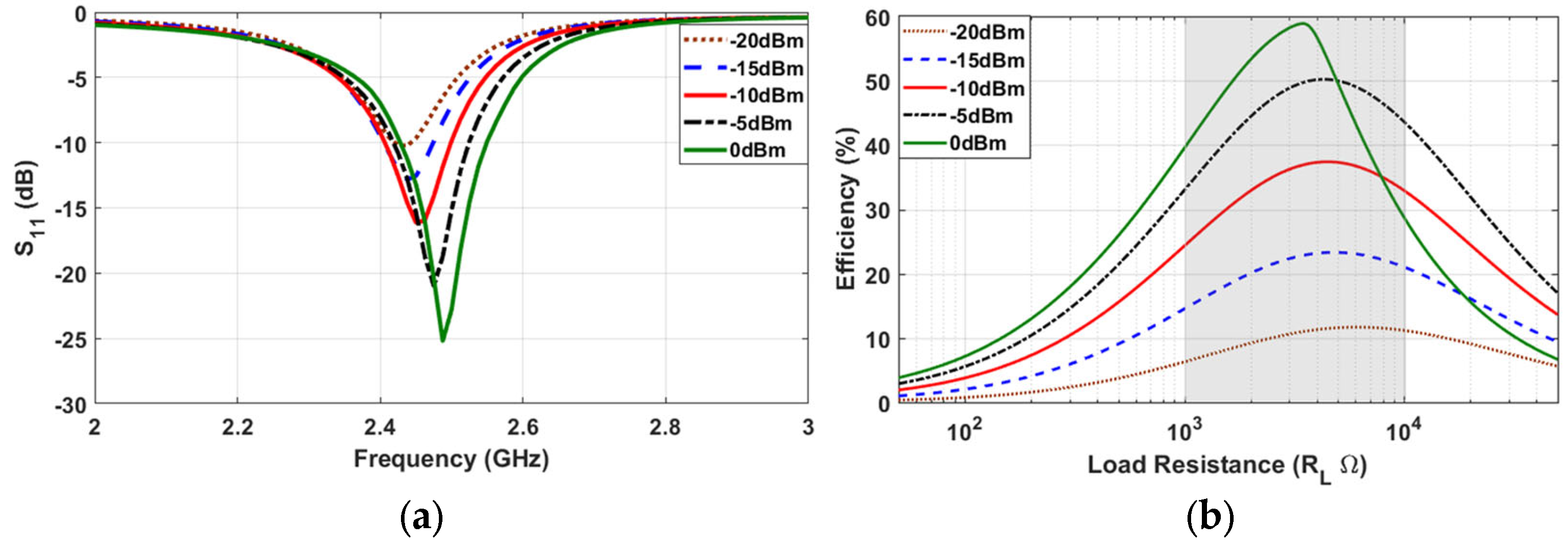
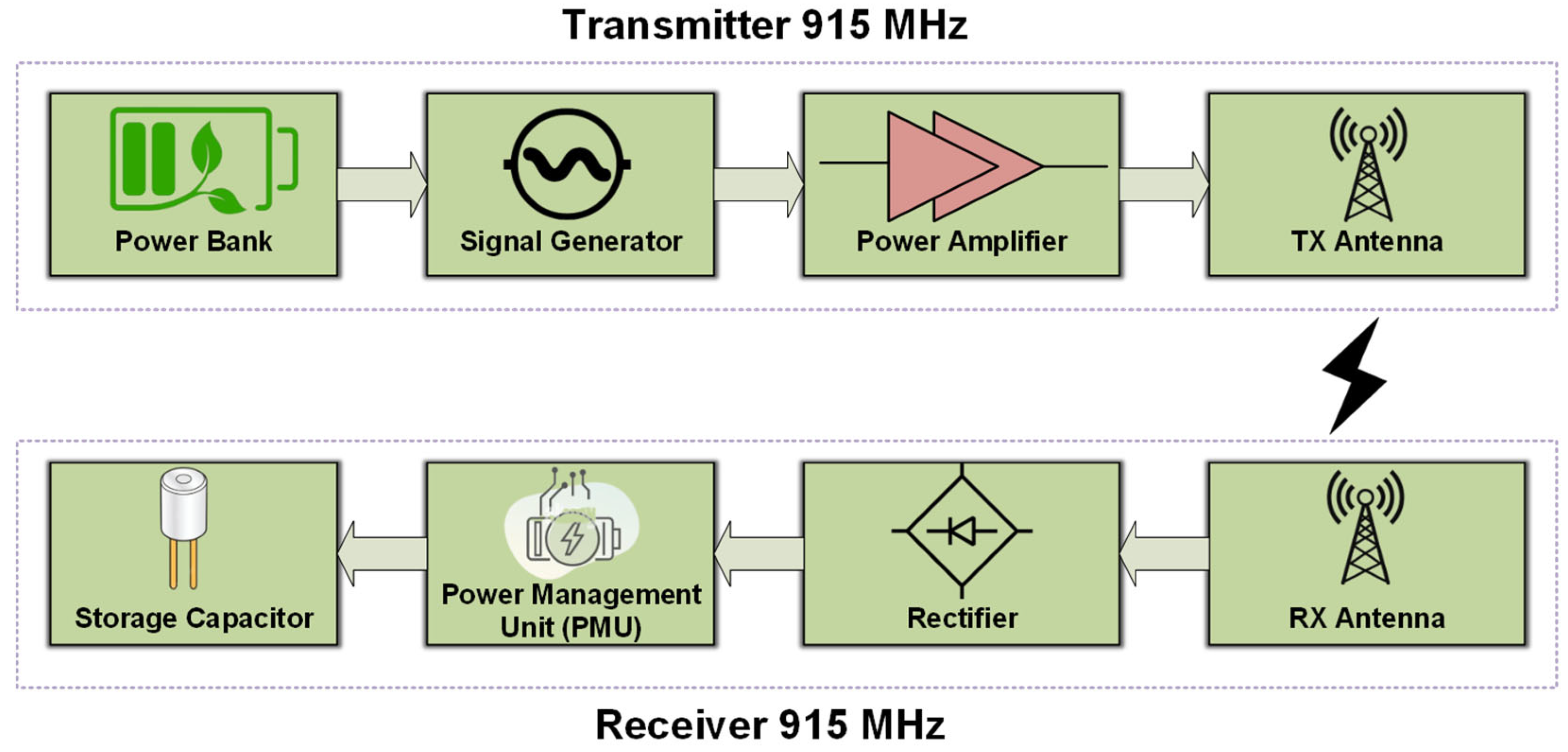
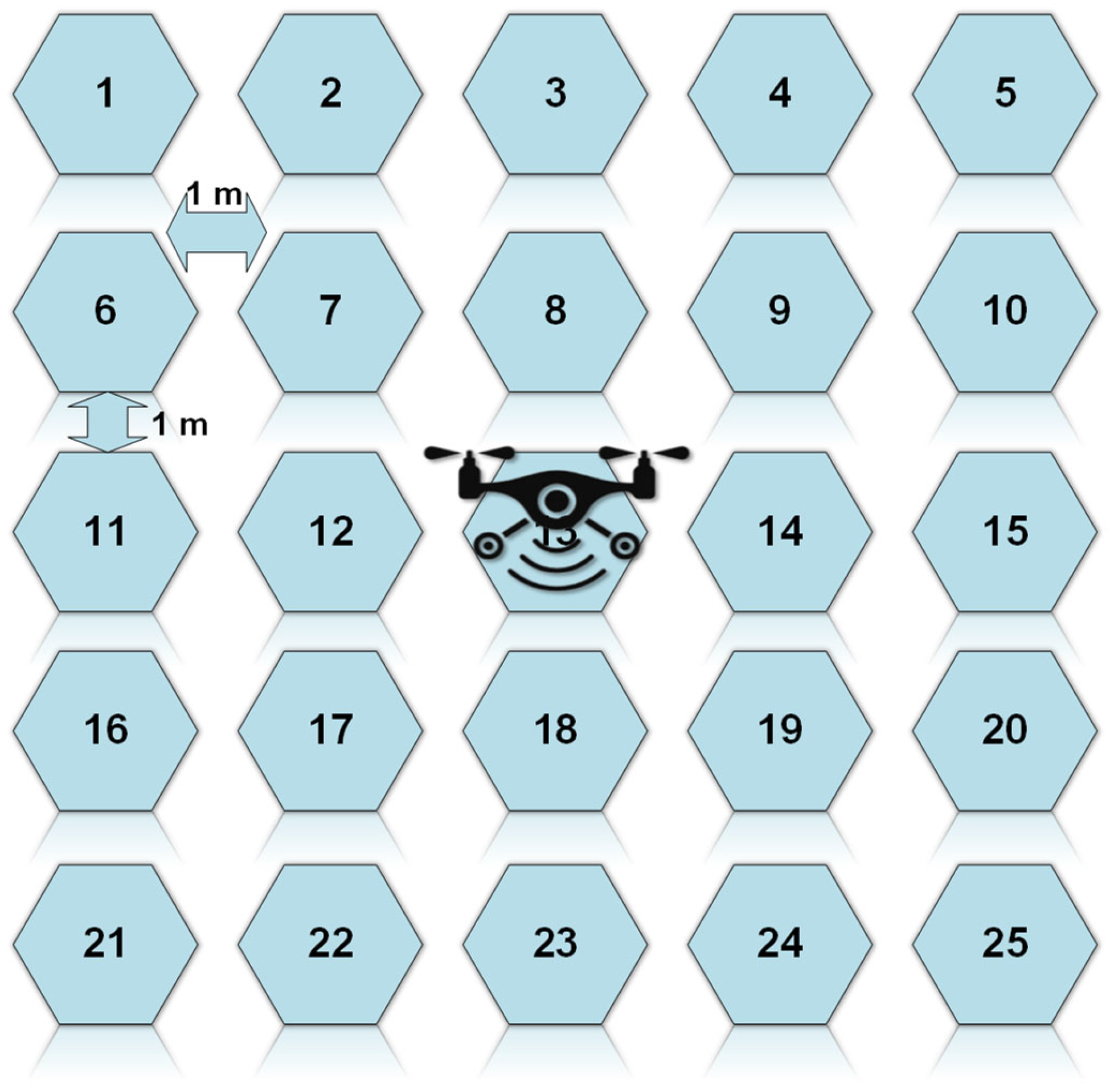

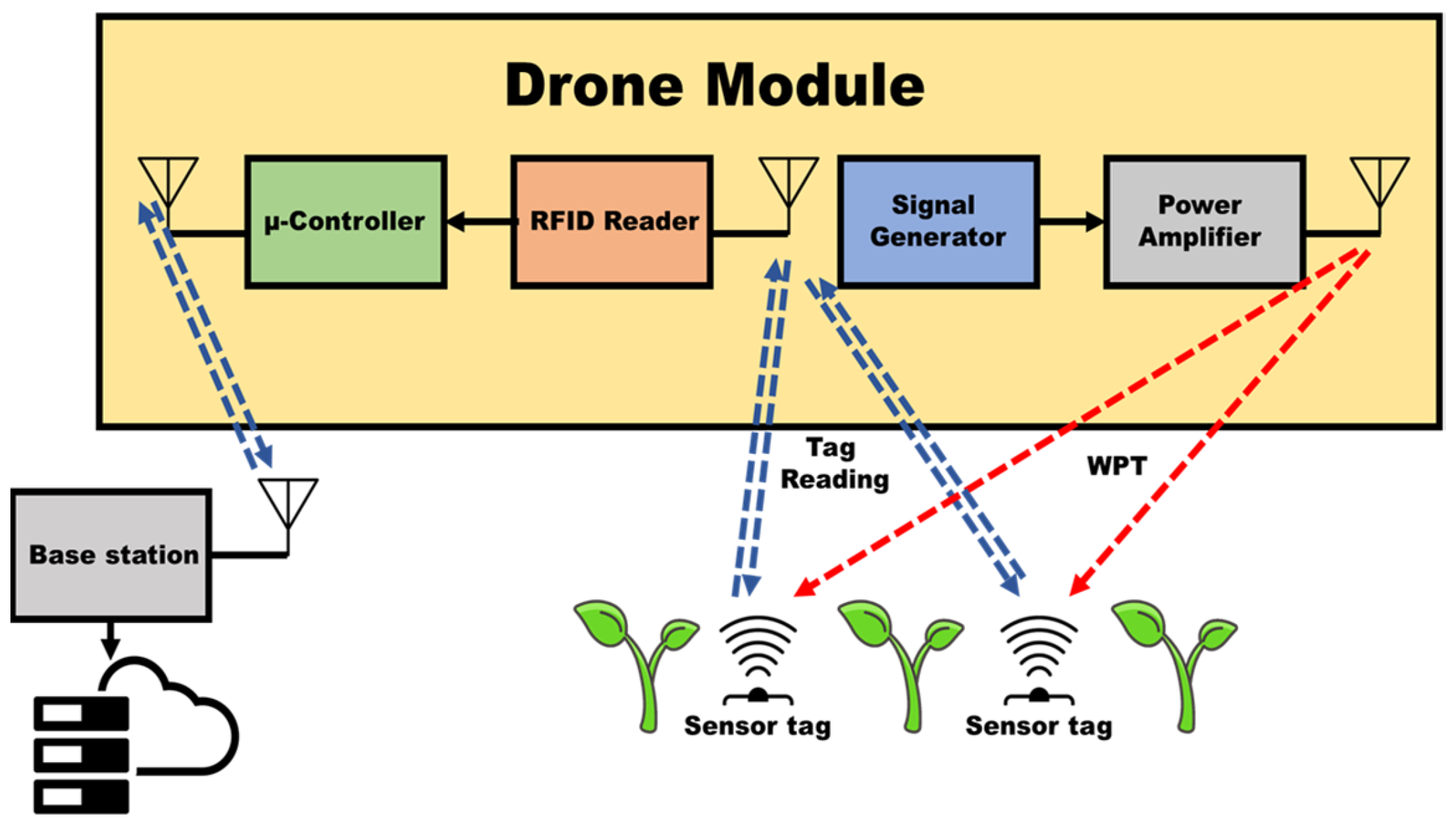

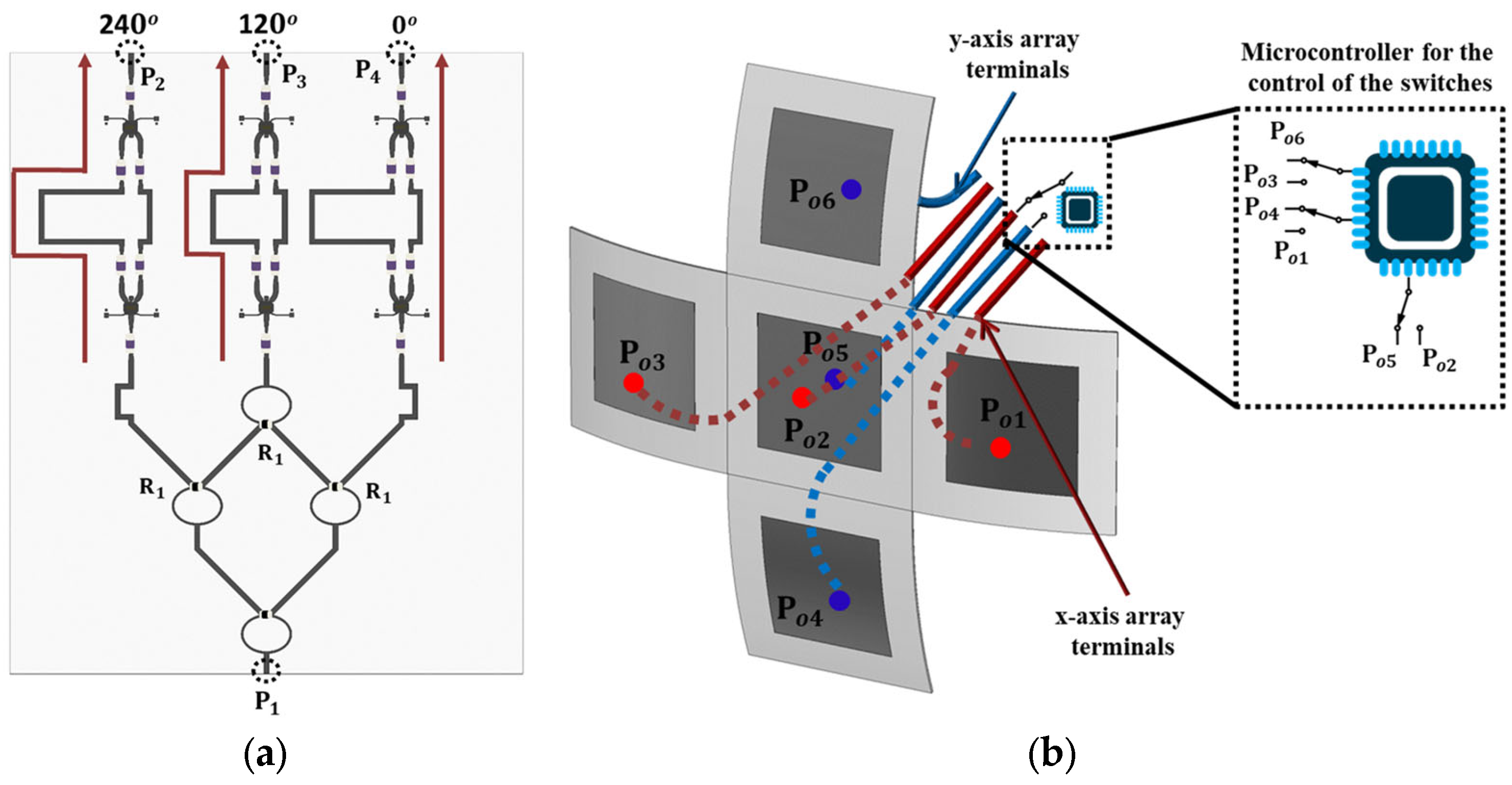
| For 3.5 GHz | ||||||||
|---|---|---|---|---|---|---|---|---|
| εr | 2 | 4 | 7 | 8 | 10 | 12 | 15 | 19 |
| tanδ | 0.05 | 0.13 | 0.15 | 0.19 | 0.22 | 0.25 | 0.28 | 0.31 |
| % of moisture | 0 | 5 | 10 | 13 | 15 | 17 | 20 | 25 |
| For 915 MHz | ||||||||
| εr | 2 | 5 | 8 | 9 | 11 | 14 | 18 | 22 |
| tanδ | 0.08 | 0.16 | 0.22 | 0.25 | 0.30 | 0.31 | 0.36 | 0.4 |
| % of moisture | 0 | 5 | 10 | 13 | 15 | 17 | 20 | 25 |
| Grid No. | Distance (m) | θangle (degree) | φangle (deg) | Charging Time (mins) | |||
|---|---|---|---|---|---|---|---|
| (1.2 V) 3.38 mJ | (1.8 V) 7.61 mJ | (3.3 V) 25.6 mJ | (3.5 V) 28.8 mJ | ||||
| 13 | 1.6 | 0 | 0 | 3.5 | 5.5 | 8 | 9 |
| 14 | 1.87 | 0 | 30 | 4 | 6.5 | 10 | 12 |
| 15 | 2.56 | 0 | 50 | 5.5 | 8.5 | 17 | 19 |
| 10 | 2.75 | 25 | 55 | 5.5 | 8 | 15 | 19 |
| 9 | 2.14 | 45 | 40 | 5 | 7 | 13 | 14 |
| 5 | 3.25 | 45 | 60 | 7 | 10 | 18 | 22 |
| Components | Power Consumption | |
|---|---|---|
| Consumed Power | Unit | |
| RFID IC ROCKY100 | 12.6 | μW |
| MCU MSP430FR2355 | 468.6 | μW |
| Humidity and Temperature Sensor SHT40 | 1.6 | μW |
Disclaimer/Publisher’s Note: The statements, opinions and data contained in all publications are solely those of the individual author(s) and contributor(s) and not of MDPI and/or the editor(s). MDPI and/or the editor(s) disclaim responsibility for any injury to people or property resulting from any ideas, methods, instructions or products referred to in the content. |
© 2024 by the authors. Licensee MDPI, Basel, Switzerland. This article is an open access article distributed under the terms and conditions of the Creative Commons Attribution (CC BY) license (https://creativecommons.org/licenses/by/4.0/).
Share and Cite
Vassiliou, L.; Nadeem, A.; Chatzichristodoulou, D.; Vryonides, P.; Nikolaou, S. Novel Technologies towards the Implementation and Exploitation of “Green” Wireless Agriculture Sensors. Sensors 2024, 24, 3465. https://doi.org/10.3390/s24113465
Vassiliou L, Nadeem A, Chatzichristodoulou D, Vryonides P, Nikolaou S. Novel Technologies towards the Implementation and Exploitation of “Green” Wireless Agriculture Sensors. Sensors. 2024; 24(11):3465. https://doi.org/10.3390/s24113465
Chicago/Turabian StyleVassiliou, Loukia, Adnan Nadeem, David Chatzichristodoulou, Photos Vryonides, and Symeon Nikolaou. 2024. "Novel Technologies towards the Implementation and Exploitation of “Green” Wireless Agriculture Sensors" Sensors 24, no. 11: 3465. https://doi.org/10.3390/s24113465
APA StyleVassiliou, L., Nadeem, A., Chatzichristodoulou, D., Vryonides, P., & Nikolaou, S. (2024). Novel Technologies towards the Implementation and Exploitation of “Green” Wireless Agriculture Sensors. Sensors, 24(11), 3465. https://doi.org/10.3390/s24113465






